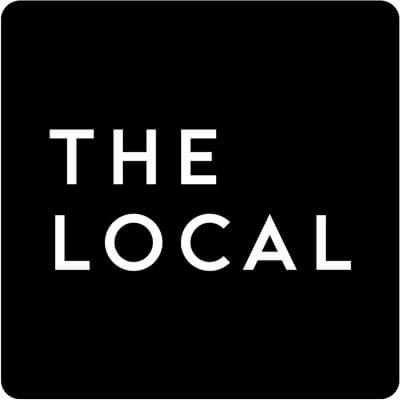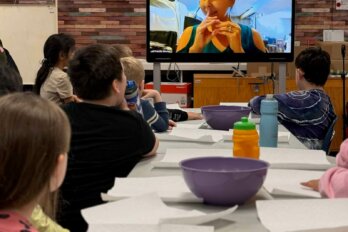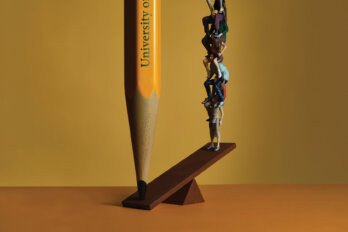
This story was originally published as “The Kids Left Behind” by our friends at The Local. It has been reprinted here with permission.
Before it all came to a head—before she started crying, screaming, and pulling out chunks of her hair—the pandemic had taken one good thing after another from the five-year-old girl we’ll call Sriya.
In March 2020, Sriya lost playgrounds and friends. Her mom, Sathya, would come home from her night shift as a nurse at a Toronto ICU and take her for a walk in the morning before falling into bed. Sriya would look over at the slides and climbers and ask why she couldn’t play. Her mom would try to explain, but Sriya didn’t understand. She would approach other kids, but their parents would pull them away. Sriya didn’t understand that either.
Sriya is autistic, and while access to funded autism services was in crisis long before the pandemic, COVID-19 put therapies further out of her reach. “We were wait-listed, and we just waited forever,” says Sathya.
In November 2020, after waiting two months, Sriya got a spot at a Toronto public school’s diagnostic kindergarten, in a class with five others. She flourished with the routine and support of her special education teacher. She went from saying “Mommy, outside” to “Mommy, let’s go outside” and “Mommy, I want to play.”
But then, in April 2021, schools closed for the third time in Ontario. While some special education programs stayed open, the needs of Sriya and her classmates weren’t considered important enough to warrant in-person schooling. A relative watched Sriya while simultaneously attending university courses online, which meant a lot of screen time. Sriya started to have meltdowns that terrified her mother. “She lost it,” she says. “She shut down. She stopped speaking as much.”
With kids back in school during this latest Omicron wave, arguments continue about which looms larger, the harms from school closures or the harms from classroom exposure to a dangerous virus. What’s often lost in these debates is the sheer magnitude of the compounded losses of the last two years for kids like Sriya. While COVID-19 has affected all kids’ learning opportunities, the impacts have not been evenly distributed. For many kids from low-income communities and single-headed households, children with disabilities and learning differences, and kids whose parents are newcomers, the pandemic has been devastating. The inequalities in education that have been widening for decades have been blown open, with some kids learning at “pod schools” with private teachers and others trying to catch Wi-Fi for virtual school from Tim Hortons parking lots.
When the virus recedes to the background, we’ll be left with kids who have missed out on developmental assessments and therapies, kids who have been traumatized by the loss of loved ones to COVID-19, and kids struggling to reintegrate into the classroom. These are the results of refusing to invest the resources into reimagining education and developmental therapies during a pandemic. The question now is whether we’re willing to help kids make up for the time and opportunities that the pandemic has taken away.
With four closures now totalling twenty-eight weeks, Ontario has had the longest school closures of any province in the country. The effects of these closures “are cumulative,” says Prachi Srivastava, an associate professor in education and global development at Western University. If it’s one closure, education staff and kids can recover; they can find ways to make up for the academic losses and the effects of isolation and uncertainty. But, if subsequent closures happen before school staff can fully evaluate and respond, Srivastava explains, the effects of each closure pile up.
These closures don’t affect all students equally. When schools have gone virtual, marginalized kids have lost access not just to in-person teaching but also to food programs and in-school counselling and therapies. Children in low-income households have had patchy access to devices, internet, and quiet rooms. Suzanne Bennett, director of social pediatrics at the Children’s Hospital of Eastern Ontario, says that, during closures, she and her staff visited families to ask what they needed. She picked up a table from a second-hand furniture store for one family. “All the kids were on the floor with the one Chromebook [laptop],” she recalls. Tesfai Mengesha, executive director of Success Beyond Limits, an organization that provides support to middle school and high school kids in the Jane and Finch neighbourhood, says that, in the first closure, some kids didn’t get a laptop until June. Mengesha’s staff would ask kids’ teachers to send them worksheets, which they’d print off and deliver. Their classmates, meanwhile, were able to interact online with their peers and teachers.
For many young children with disabilities, virtual school has proven to be developmentally inappropriate. Kim, a mom in Burlington, recalls her son’s teacher playing yoga videos for the kids a number of times despite her explaining that, with his cerebral palsy, her son couldn’t do most of the moves. “He would just get bored and walk away,” she says.
During school closures, some children have also had to take on caregiving roles. Rachel is a teacher at a Catholic school in a low-income Toronto community. (She is using her first name to avoid identifying the children she teaches.) She remembers trying to teach one student who was supervising her four younger siblings. “I would call on her and she would type to me, ‘Hey, Miss, I’m so sorry. My brother’s lunch is in like an hour. I can come back then and talk to you. Can you record the Zoom? Can I watch it later?’”
A Toronto District School Board (TDSB) teacher named Andrea describes an eleven-year-old student, home alone with his siblings, asking her if they should leave the building during a fire alarm or if it might be better not to risk the crowds on the way out. “They had to make adult decisions,” says Andrea. She thinks the past two years have really brought home the fact that school is about more than math and reading. “The act of going to school had so many other wellness factors—getting outside, getting sunlight, being checked in on by caring adults who are way less stressed than your own adults in your life.” For some, she says, school is the only place they feel safe.
Other students simply disappeared from school altogether. Kevin, a high school senior at Westview Centennial Secondary School, says it’s been hard to find opportunities to ask questions in virtual school because there’s no teacher’s desk to approach. Sometimes “even the teachers have their video off,” he says. “I was looking at a lot of black screens with just names.” When school pivoted to virtual last year, some students he knows, including some who had been doing well, “just dropped out.” Richard Spiegel, a high school teacher in Etobicoke, says that, in the closure last spring, he noticed that a few students “just kind of disappeared.” When he tried calling, he couldn’t get through.
The last few weeks have seen heated, sometimes ugly debates about whether schools should be open, with the plight of low-income kids often marshalled on either side. But the reality is that simply opening schools doesn’t prevent the massive inequities kids are experiencing in the pandemic.
When schools are open, most parents do choose to send their kids. In September 2020, about one-third of students remained in virtual school while two-thirds were in-person. But, throughout the pandemic, low-income families have been overrepresented in Zoom classrooms. People from low-income homes face much higher COVID-19 rates. They often work jobs that won’t accommodate frequent isolation periods. Many live in intergenerational homes, making a positive case in a child extremely dangerous to their loved ones. These factors combine to make people from low-income communities far less likely to choose in-person school during a pandemic.
In the TDSB, students from low-socioeconomic-status households made up 31 percent of the students in classrooms in fall 2020 and 46 percent of those in Zoom rooms. Students from high-income households followed the opposite pattern, making up 37 percent of in-person students and only 15 percent of online students. Just 14 percent of online students were white while 35 percent were South Asian.
Mengesha says that, in 2020/21, only about half of the high school students returned in person to Westview Centennial School, where his organization operates a youth space. “The northwest Toronto community has been one of the hardest hit throughout the pandemic, so safety was a huge concern,” he says. And, for kids with disabilities, the calculations and trade-offs become impossible. COVID-19 poses more of a health risk to many children who have disorders that affect their learning. “The kids who really need face-to-face services are often also the ones who are most vulnerable to infection,” says Kathryn Underwood, a professor in the school of early childhood studies at Ryerson University.
For the parents who did decide to keep their kids at home, the virtual option hasn’t been easy. While disproportionately chosen by low-income families, virtual school has been more poorly funded than in-person school. For one, the classes have been bigger. In the TDSB, virtual classes for grades four to eight were capped at thirty-five students compared with twenty or twenty-seven for in-person classes depending on whether they were in a high-risk neighbourhood. And, in the current school year, high school students were often in virtual hybrid classes, meaning teachers simultaneously taught the students in front of them and those at home on their laptops. Depending on the set-up, the virtual students might see PowerPoint slides and a chalkboard with a teacher flitting onto and off of the screen. Rachel says that, at her high school, about half of virtual students are failing.
Syed is a father in the East York neighbourhood of Thorncliffe raising four kids with his wife in a two-bedroom apartment. They made the decision to keep three of their kids at home during the first full school year of the pandemic while their fourth attended a small special education program. This year, they kept their daughter at home because she was too young for the vaccine, but they sent their other kids. Syed has been able to stay home with the kids while his wife continues working part-time after having to quit another part-time tech support job to be there for her children. “Everybody’s in high stress,” says Syed. “The kids are under stress, under the constant watch of their parents.”
Money has been tight during the pandemic, but Syed says the bigger difficulty has been navigating virtual school schedules and internet access. In one month, Syed counted five internet outages in his building, some of them lasting hours. Syed and his wife would let their children use their cellphone data, but sometimes they’d run through their monthly limit within a few days. To preserve data, he would drive his eldest to the Tim Hortons parking lot so they could access the Wi-Fi.
How have the past two years of pandemic stress and disrupted learning affected kids? Global studies suggest that learning losses have been most significant in primary grades and among marginalized groups, with one study finding that learning losses were 60 percent larger if children’s parents didn’t have higher education. The picture is less clear on the mental health impacts, and experts have pointed out that both life and routine disruptions, as well as the mental health strain of catching COVID-19 and passing it on, are significant.
What is clear is that an educational recovery plan needs to address pandemic stress. According to TDSB data, 77 percent of elementary school students reported that they were “happy” in 2017; by fall 2021, that had dropped to 46 percent. For secondary school students, those numbers fell from 66 percent to 33 percent. Bennett says her pediatric colleagues are seeing increased referrals for symptoms of attention deficit and hyperactivity disorders, “symptoms that can be from trauma and stress,” in younger kids, as well as “increased anxiety, depression, and aggressive behaviours in older kids.”
In northwest Toronto neighbourhoods, Mengesha says, the additional stress makes it hard for young people to make school a focus. “All of those things that come with a lower income, whether it’s food on the table, whether it’s transportation, all those things that existed before the pandemic are still there. But they’re worse,” he says. “Schooling doesn’t happen in a vacuum. It happens within the context of young people’s lives.” Again, the effects compound. From fall 2020 to fall 2021, the TDSB saw an 86 percent increase in referrals for social work support and a 62 percent increase in referrals to attendance counsellors, suggesting a higher level of trauma a year and a half into the pandemic.
Kids’ emotions are more likely to show through their actions than through their words. “As a school community, we’re talking a lot about the complete loss of study habits and social norms like everyday social etiquette,” says Rachel. From September to December of this academic year, staff at her school had already carried out three risk assessments after a child threatened violence against the community; typically, says Rachel, there’s one, if that. “They are all dealing with the trauma of the past year and a half,” she says. “There are probably a lot of mental health issues that are not being diagnosed.” In fall 2021, in the first two and a half months of school, there were twenty-seven suspensions of twenty days across the TDSB. Such long suspensions are serious, reserved for the most extreme transgressions. In the same period in 2019, there were just two long suspensions, and in 2020, there were none.
In addition to learning loss and untreated mental illness, experts are worried about undiagnosed and undertreated developmental conditions. Whether due to closures or to parental concerns about COVID-19 exposure, “we have a whole generation that missed out on early years centres, preschool programs, parent and kid music classes,” says Underwood. In fall 2021, optional enrolment in junior kindergarten across the TDSB was almost 10 percent lower than expected. Those programs are not just places to nurture important connections at a time when the brain is most actively learning—they’re also where early childhood educators identify early signs of autism and other developmental disorders or make referrals to speech therapy. “We know that the early years are when our brain architecture really starts to come together and solidify,” says Ripu Minhas, a developmental pediatrician at St. Michael’s Hospital. His hospital is seeing a swelling wait list of kids with developmental and academic concerns. “There is a feeling that these kids didn’t get the same sort of eyes on them when they were in a virtual space,” he says. “They’re presenting to the system later, and that is of note because we know that earlier identification and interventions are important.”
Once parents realize they need assessments and therapies for their children, they’ve been faced with insurmountable barriers. Assessment centres shut down in the first wave. Many autism and other learning therapies also closed completely in the first wave, and some, especially those involving small-group facilitated play, still haven’t restarted. Some speech and occupational therapy services still offer only virtual services.
Charlotte Schwartz is a Toronto mom with a ten-year-old son who is autistic. “He doesn’t understand things that aren’t physically present,” she says. “For weeks, he thought he could touch his teacher by touching the screen.” Today, she says, services are “full, not running right now, or unwilling to take on clients who don’t want to do twenty hours a week of services. It’s been harrowing.”
This school year, Sriya has been fortunate to have in-person occupational play therapy. She’s been doing well, carrying on conversations and creating elaborate dramas with dolls. Her teachers think it would be good for her to join a regular kindergarten class. (The kids in her current class are nonverbal.) But, rather than letting Sriya visit a kindergarten classroom a couple of afternoons a week and gradually increasing her time based on how well she responds, her mom’s only choice is to transition full-time. Even in fall 2021, when cases were low and kids were going from classrooms to ballet and hockey, the school administration couldn’t allow Sriya to move between two classrooms because it would be mixing cohorts.
As Underwood says, “Open schools haven’t really been open schools.” Throughout the pandemic, supports for kids with disabilities have been treated like “a nice thing to have,” she says—easily sacrificed to wider mitigation goals.
It didn’t have to be this way. What’s needed for safe schools—from better personal protective equipment to prioritized testing to paid sick days—has been well documented. A more concerted effort to prioritize safety could have given more families the confidence to choose in-person learning or avoided closures altogether. We could have also viewed services for autism and other developmental disorders as essential and tasked infectious-disease and pediatric experts with figuring out how to safely deliver them—instead of using COVID-19 as a blanket reason to stop in-person delivery of these highly time-sensitive services altogether.
We should have funded virtual schooling better, with internet-connected spaces for those who need them and check-ins with social workers or tutors. Education ministries should have figured out how to design pandemic education in developmentally appropriate ways, determining which parts of the curriculum were better suited for in-person versus online delivery, synchronous versus asynchronous. As Srivastava points out, the lack of planning was understandable in the first closure; by the third, it was unforgivable.
But our underfunded systems simply couldn’t support creative solutions to deliver schooling and developmental therapies to kids in a pandemic. “We’ve seen a decline in funding for public education and health care over decades,” says Jess Lyons, a spokesperson with the Ontario Parent Action Network. The cutbacks by Doug Ford’s Conservative government, just before the pandemic, amounted to $68 million from the TDSB alone, and reductions in reading coaches, speech pathologists, social workers, guidance counsellors, and psychologists “were particularly cruel and stark,” says Lyons.
Where do we go from here? Shelley Laskin, the TDSB trustee for Eglinton–Lawrence and Toronto–St. Paul’s, isn’t ready to say how much more we should be spending on education. We should start with our goals, she says, and then fund the measures needed to achieve them. This means deciding that every child needs access to a laptop, both for tech equity and emergency reasons. It means making sure that students who are reading well below grade level get services such as guaranteed one-on-one tutoring hours each week. It means providing an interview with a counsellor for every child, to determine what supports they need. As part of its pandemic recovery plan, the TDSB, currently facing a funding shortfall of over $60 million due to pandemic-related costs, is creating six new social worker positions and hiring thirty-five child and youth workers and fifteen counsellors. It’s progress, but for a board serving close to 250,000 students across 600 schools, it’s clearly not enough.
And, to make up for the learning losses, it’s more apparent than ever that we need smaller class sizes. The wait lists are long for independent education plans, legal documents that outline tailored learning strategies and goals for children with learning differences. But, says Lyons, “the number of children who need independent education plans goes down significantly when the class sizes are smaller and teachers and education workers have the time to spend instructing in different ways and giving one-on-one attention.”
For Suzanne Bennett, any pandemic recovery plan needs to involve finding ways to bring joy into kids’ lives. Her clinic hands out museum passes and connects kids to free music programs and swimming lessons, for instance. “Everybody talks about the adverse childhood experiences, which really can impact long-term outcomes for health and education,” says Bennett. “We need to start talking about positive experiences and what they do.”
More than anything, she says, we need to consult children themselves about what they want, for their schools and their communities. Over the last two years, we’ve said that learning is essential but have refused to make the bold decisions or tough sacrifices to back up those words. Now, it’s time to face the repercussions of our policy failures and listen to those most affected by our choices. “The kids, we don’t hear from them,” says Bennett. “We need to get them involved in the policy decisions. We need to be listening to them.”
This story was reprinted with permission from The Local




